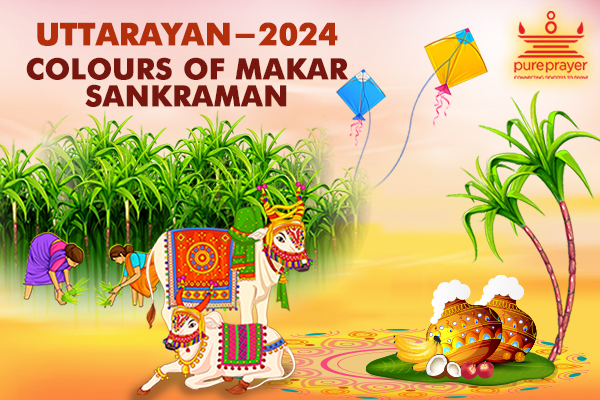Makar Sankraman On January 15, 2024
Best wishes and greetings to all from PurePrayer on the occasion of Makar Sankraman being performed on January 15, 2024
Makar Sankraman or Makar Sankranti is celebrated all over India and is a very important festival. Being the time of harvest, Makar Sankranti is a festival celebrated offering the first harvest of the season to gods. This festival has different names like, Bihu in the North-Eastern India, in the states of Odisha (Orissa), Assam. In Punjab this is celebrated as Lohri. While in Gujarat, this is simply known as Uttarayan. Sankranti in the region of Bengal, this is celebrated as Ganga-Sagar Mela. In South Indian state like Andhra Pradesh, Karnataka, Kerala, Tamil Nadu and Telangana the festival is observed over three to five days. While it is Bhogi festival among the Telugu speaking, it is Pongal in Tamil Nadu and Kerala.
Makar Sankranti is called Suggi (ಸುಗ್ಗಿ) in Kannada, representing the harvest.
What is Makar Sankraman?
In the Hindu Sanatan Dharma, we have the practice of celebrating transit (Sankraman) of Lord Surya (Sun God) into different constellations of the Zodiac. They are the festival times known as Sankranti and the best time to offer obeisance to Lord Surya. He is offered Pujas on all these Sankramana days. Also, this day is considered highly ideal to offer Tarpans.
However, the Makara Sankraman or Makara Sankranti is considered the most auspicious of all these days. The reason being, our Panchangam for the Samvatsar (Calendar year) is divided into two parts known as Dakshinayan and Uttarayan representing six month periods each. Makar Sankranti is the first Sankraman to occur in the Uttarayan.
Let’s learn what these Uttarayan and Dakshinayan are. Puranas state that the time period of one Samvatsar (year) is equivalent to a day’s time for Gods. While Dakshinayan is the night time for them, Uttarayan is the day time. Makar Sankranti is the first Sankraman that takes place in Uttarayan Punyakaal. Hence, Makara Sankranti is observed with a great reverence.
Ganga Sagar Mela has its origins in the period of Treta Yug. Rishi Bhagirath, a king and the great sage born in the dynasty of Raghu, was successful in bringing Ganga to provide Moksha (The Salvation) to his forefathers. Deva-Ganga appeared before Bhagirath who performed a long penance and asked him to pray to Lord Shiva. She said, only Shiva can control the forces of Dev-Ganga when she dived from the heavens and descended on the earth. Bhagirath pleased Lord Shiva, who was successful in locking up Deva-Ganga in his matted hair. Later, Ganga flowed from Lord Shiva’s hair, covered the ashes of Bhagirath’s forefathers who had been punished by Kapil Muni, thereby giving salvation. She continued her journey till she unified with the Mahodadhi (the Bay of Bengal). Devout Hindus in the region of Bengal take a journey to Sagar Dweep (An island) and offer Pujas to River Ganga on this occasion.
The great epic of Mahabharat penned by Lord Ganapati and dictated by Maharshi Veda Vyas mentions that, Bheeshma Pitamah (grandfather of Kauravas and Pandavas) lay in the bed of arrows (Shar Shayya) after the battle in Kurukshetra, waiting for the beginning of Uttarayan Punyakaal to give up his mortal body.
As he remained a bachelor and observed Brahmacharya, it is our responsibility to offer Tarpan in his name.
Also, Uttarayan ushers in a change in the Rutu (Season). Hence, many dishes that can help us protect and nourish our body are prepared and offered to the gods as Naivedyam. Dishes based on moongdal and rice with lots of pepper are popular in the South India. Sarson ka Saag is the order of the day in the north. Many dishes are prepared using pumpkins in the Telugu speaking region. Sweets and condiments are prepared using Til (sesame) and Gud (Jaggery) in large quantities for distribution among friends and relatives. Also prepared are miniatures of many fruits, animals and shapes in ‘Sugar Candies’ for distribution. Sugar cane pieces, bananas and many other presents are also distributed visiting relatives and friends.
How is Makar Sankraman or Makar Sankranti celebrated?
In the holy book of Nirnaya Sindhu, the procedure of celebrating Sankranti festival is mentioned as below:
|| तस्यां कृष्णतिलैस्नानं कार्यं जोद्वर्तनं शुभैः |
| शिलादेयाश्व विप्रॆभ्यो सर्व देवोत्तरायणे |
| तिल तैलेन दीपाश्व देया देवगृहे शुभाः ||
|| ತಸ್ಯಾಂ ಕೃಷ್ಣತಿಲೈಸ್ನಾನಂ ಕಾರ್ಯಂ ಜೋದ್ವರ್ತನಂ ಶುಭೈಃ |
| ಶಿಲಾದೇಯಾಶ್ವ ವಿಪ್ರೇಭ್ಯೊ ಸರ್ವ ದೇವೋತ್ತರಾಯಣೆ |
| ತಿಲ ತೈಲೇನ ದೀಪಾಶ್ವ ದೇಯಾ ದೇವಗೃಹೆ ಶುಭಾಃ ||
|| tasyAM kRuShNatilaisnAnaM kAryaM jOdvartanaM SuBaiH |
| SilAdEyASva viprEByo sarva dEvOttarAyaNe |
| tila tailEna dIpASva dEyA dEvagRuhe SuBAH ||
On the day of Makara Sankranti, Til oil or castor oil is smeared on our body before dawn. After the bath, new clothes are worn. In Teertha Kshetras (Pilgrim centres), taking a dip in holy rivers like Ganga, Yamuna, Saraswati, Narmada and Kaveri is believed to be very auspicious and meritorious. In Prayag, the Sun god is especially worshipped and a holy dip is taken in Ganga. Once in twelve years, the Maha Kumbha Mela is celebrated on Makara Sankranti in Prayag on the banks of Ganga.
PurePrayer is a leading online platform offering Purohit Services of experienced and Vedic Pandits in all the Metro Cities of India like Chennai, Delhi, Gurugram, Hyderabad, Kolkata, Mumbai, Mysuru, Pune and many others as well as in Teertha Kshetras across India. We provide the services of Bengali Pandits, Hindi Pandits, Kannada Poojaris, Kashmiri Pandits, North Indian Pandits, Tamil Vadhyars, Telugu Purohits, Marathi Guruji, Malayalam Pandits, Oriya Pandits and many more. Pandits are available in Offline or Remote support format.
Please visit www.pureprayer.com or call us on +91 8151002255, WA No: +91 9606036988 to learn more about booking online Pandits/Purohits for all Pujas, Havans and many more.


Leave a review